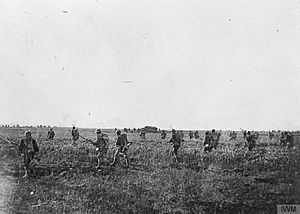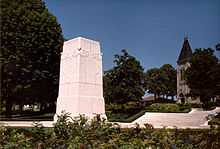Battle of Cantigny
| Battle of Cantigny | |||||||
|---|---|---|---|---|---|---|---|
| Part of Western Front, World War I | |||||||
 Attack and taking of Cantigny by 28th Infantry Regiment, American 1st Division supported by the French 5th Tank Battalion, 28 May 1918. | |||||||
| |||||||
| Belligerents | |||||||
|
|
| ||||||
| Commanders and leaders | |||||||
|
|
| ||||||
| Strength | |||||||
| ~4,000 | Unknown | ||||||
| Casualties and losses | |||||||
|
| 250 captured | ||||||
| ||||||
The Battle of Cantigny, fought 28-31 May 1918[1] was the first American battle and offensive of World War I..[2] The U.S. 1st Division, the most experienced of the seven American divisions then in France and in reserve for the French Army near the village of Cantigny, was selected for the attack. The objective of the attack was both to reduce a small salient made by the German Army in the front lines but also to instill confidence among the French and British allies in the ability of the inexperienced American Expeditionary Force.
Background
The Americans desired to make a show of strength after the U.S. 26th Division was surprised in the line by a raid on Seicheprey on April 20–22. A division attack to retake Montdidier was contemplated but ruled out because it would also involve supporting attacks by French divisions on either side. Instead a single regiment was tasked to take and hold Cantigny, which was located relatively close behind the front, but also subject to intense counter-attack. Jump-off trenches were dug in preparation, resulting in a massive gas attack on the Americans by the Germans on the day before the planned attack, in which 15,000 gas shells were fired, cutting off all communication with the forward positions. When German probes had been found to have been repulsed,the attack was ordered to go forward as planned.
Cantigny was the point of a salient into the Allied lines approximately 5 kilometres (3.1 mi) deep, and was held by two battalions of German infantry.
Capture of Cantigny
At its 06:45 H Hour, American troops left their jump trenches following an hour-long preparatory artillery barrage in which German counter-battery fire nullified the location of German artillery positions. A rolling barrage advancing approximately 100 meters every two minutes preceded the attacking troops.
The 28th Infantry Regiment (Col. Hansen Ely, commanding) plus three machine-gun companies and a company of engineers(3,564 troops), all of the 1st Division, under Major-General Robert Lee Bullard, captured Cantigny from the German Eighteenth Army commanded by von Hutier. The village was situated on high ground surrounded by woods, making it an ideal target for German artillery.
Aiding the capture, the French provided air cover, 368 heavy guns, trench mortars, tanks, and flamethrowers. The advancing American infantry was aided by ten Schneider tanks of the French 5th Tank battalion, used to eliminate German machine gun positions. .[3] With this support, and advancing on schedule behind a creeping artillery barrage, the 28th Infantry took the village in 30 minutes. It then continued on to its final objective, positions 2 kilometres (1.2 mi) from its jump-off point, just as the rolling barrage reached its final line, at 08:13.
Defense against German counterattacks
The first German counterattack, a small attack at 08:30 against the extreme right of the new American position, was easily repulsed, but German artillery bombarded the 28th Infantry for most of the day. At 17:10 the first large-scale counterattack took place, and a company of the 1st Battalion of the 26th Infantry commanded by Major Theodore Roosevelt, Jr. was used to reinforce a weak spot in the American line. Another German counterattack at 18:40 was also repulsed by a combination of artillery and Infantry defensive fire. A series of counterattacks over the next two days were also defeated by both American regiments, and the position held.
The Americans reduced the salient and expanded their front by approximately a mile. A minor success, its significance was overshadowed by the battle underway along the Aisne. The U.S. forces held their position with the loss of 1,603 casualties including over 300 killed in action; they captured 250 German prisoners. Matthew B. Juan, a Native American war hero, was killed during this battle..[4]
The American success at Cantigny assured the French that American divisions could be entrusted in the line against the German offensive to take Paris. The victory at Cantigny was followed by attacks at Château-Thierry and Belleau Wood in the first half of June.
Monuments
Battle

The American Battle Monuments Commission erected a monument in the village of Cantigny that was dedicated on 9 August 1937 with a speech given (at the invitation of General John J. Pershing) by Col. Robert R. McCormick, who had commanded the 1st Battalion of the 5th Field Artillery regiment at the battle. on one side of the memorial appears the inscription:
- ERECTED BY THE UNITED STATES OF AMERICA TO COMMEMORATE THE FIRST ATTACK BY AN AMERICAN DIVISION IN THE WORLD WAR.
On another side of the memorial appears the inscription:
- THE FIRST DIVISION UNITED STATES ARMY OPERATING UNDER THE X FRENCH CORPS CAPTURED THE TOWN OF CANTIGNY ON MAY 28 1918 AND HELD IT AGAINST NUMEROUS COUNTERATTACKS.
French translations of these inscriptions appears on the opposite sides of the monument.
First Division
A First Division Monument located along the road ½ mile southeast of Cantigny, is one of five erected by the First Division itself in 1919. The names of dead in the vicinity of Cantigny are engraved on the bronze plates. The monument is like a small concrete shaft, surmounted by a carved eagle of stone.
McCormick
In the center of Cantigny, a small monument was dedicated in 2005 by the McCormick Foundation to commemorate the participation of Major Robert R. McCormick in the historic 1st Battalion, 5th Field Artillery, the oldest American military unit on continuous active duty (dating back to the American Revolutionary War), then part of the First Division.
Black Lions
On May 28, 2008, the 90th anniversary of the Battle of Cantigny, the McCormick Foundation and the Association of the 28th Infantry Regiment dedicated the statue "The Lion of Cantigny," an original bronze work by Stephen Spears depicting a doughboy of the regiment advancing through the village. The 28th Infantry was the assault regiment in the First Division's attack, the first major US battle of World War I. The regimental coat of arms is based on the lions in the heraldic arms of Picardy, where Cantigny is; the regiment's nickname is Black Lions.
See also
References
- ↑ First World War.com - Battles - The Battle of Cantigny, 1918
- ↑ Davenport, Matthew J. (2015). First Over There. New York: St. Martins. ISBN 1250056446.
- ↑ Davenport, Matthew J. (2015). First Over There. New York: St. Martins. ISBN 1250056446.
- ↑ Davenport, Matthew J. (2015). First Over There. New York: St. Martins. ISBN 1250056446.
External links
- Battle of Cantigny at the American Expeditionary Force website
- American Battle Monuments Commission website
- First Division Museum website
- "Citizen Soldier: Colonel McCormick and the Battle for Cantigny" Panel Discussion at the Pritzker Military Library on November 14, 2012